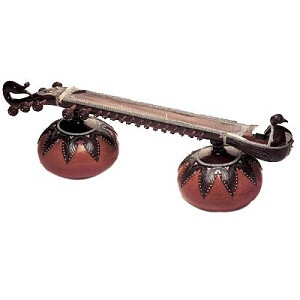Vichitra Veena
 The vichitra veena came into the limelight towards the beginning of the twentieth century. Though its structure, quite similar to the rudra veena, appeared for the first time in the early years of the twentieth century, the technique used to produce the notes is ancient.Thus it can be propounded that it is a developed and modified version of an ancient instrument.
The vichitra veena came into the limelight towards the beginning of the twentieth century. Though its structure, quite similar to the rudra veena, appeared for the first time in the early years of the twentieth century, the technique used to produce the notes is ancient.Thus it can be propounded that it is a developed and modified version of an ancient instrument.
In general appearance and structure, vichitra veena looks similar to rudra veena or the been. The main difference lies in the production of sound. The been has frets whereas the vichitra veena is a fretless zither. While playing, the rudra veena is held diagonally across the body of the player in such a manner that the upper gourd rests on the shoulder and the lower one rests on the thigh, whereas the vichitra veena is put in front of the player while playing. To produce notes, a paperweight or a rounded glass piece is held and slided by the left hand upon the strings.
The wood used for making the vichitra veena is sisam, tun or teak. It has a huge body. The fingerboard, called dand is about fifty inches long, about four to five inches wide and about two-and-a-half to three inches in diameter. This dand can be divided into two parts. The first part, almost of twelve inches, contains the peg box with six large pegs of the main playing strings. It is open from the bottom and fixed tightly onto the main body of the instrument. The second part is about thirty-six inches long. In this portion, three drone strings on the right and two on the left, and eleven to fifteen tuning pegs of tarab strings (sympathetic strings) are fixed on the right side. At the end of the fingerboard or dand there is a string holder called the langot, where all the strings are entangled with loops.